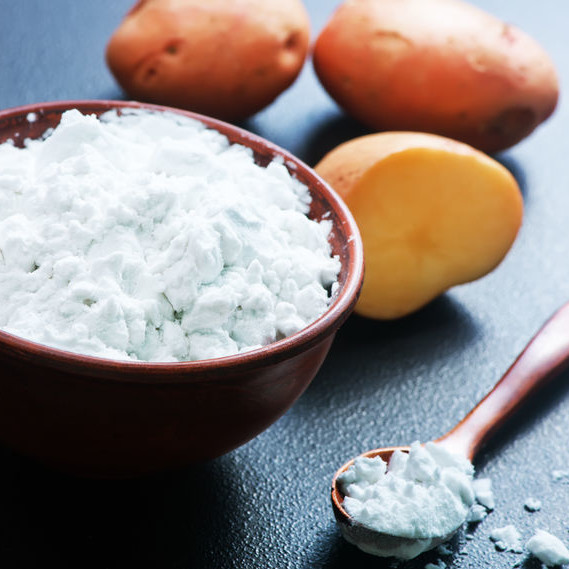Potato Starch
What is Potato Starch?
Potato starch is a fine, white powdery substance derived from potatoes. Similar to other starches, it is commonly used to thicken, gel, texturize and increase crispiness in baked goods. It is also used in clear soup, confections, fillings, and so on.
Properties such as high water-binding capacity, low gelatinization temperatures and tendency to form relatively clear, highly viscous pastes are some of the most beneficial aspects of using potato starch in food systems.
Origin
Potatoes originated in South America about 13,000 years ago, where the Incas cultivated and consumed it. During the conquest of Peru and Chile between (1525-1543), the Spaniards discovered potatoes and brought the crop back with them to Europe in the 1570s. A few decades later, European farmers began to produce starch from potatoes which they first used to starch linen. Further on, monarchies in Europe used it to powder their wigs and faces, a fashion trend at the time.1,2
Composition
Potato starch consists of 21-25% amylose and 75-79% amylopectin. Industrial grade potato starch is dried to 17-18% moisture content, 0.35% ash, 0.1% water solubles, traces of nitrogen and sugar.2
The presence of phosphate groups on the amylopectin molecule makes it sensitive to electrolytes such as potassium and calcium. This may explain the challenges with potato starch dissolution and gelatinization behavior in hard water.2,3
Nutrition
Potato starch is largely resistant to digestion in the small intestine. Since it is an uncooked resistant starch, it can be categorized as RS 2.4 It is gluten free.
Commercial production
Traditionally, potato starch is extracted from potato cultivars that are rich in starch, typically, 22%.2 The process consists of washing the potatoes, disintegrating them to break the cells open and release starch granules along with broken cell wall and other cell contents. Normally, sulphur dioxide is added to inactivate oxidative enzymes and prevent discoloration.
Disintegration can be done using hammer mills (U.S.) or rotary saw blade rasps (Europe). The macerated potato is forced against a screen through which starch and fibre are physically removed from the juice. The pulp is screened through a rotary sieve and concentrated using a continuous centrifugal separator where fiber and extraneous matter are removed.
In potato and other starches, gelatinization of amylose results in crystals which can reduce the paste clarity. Chemical treatment can help overcome this problem although this process is expensive and often inefficient. In 2005, a new, non-GMO potato variety was introduced. More recently, CRISPR CAS9 technology and tilling have also been used to develop amylopectin-rich potato starch.2
Similar to other starches, potato starch can be modified via degradation or cross-linking to improve its functionality.
Function
Potato starch is preferred over corn starch and other starches in many applications due to the following properties:
- High consistency in pasting and viscosity reduction upon heating
- Excellent film forming capabilities
- High binding power
- Low gelatinization temperature
- Formation of clear pastes due to purity (only residual amounts of lipids and proteins)
- Neutral flavour
- Higher degree of swelling than cereal starches
Applications
Potato starch and modified potato starch are used typically in the following applications:
- As cold thickeners in pies and pastry fillings
- In confections, cheese analogues, glazing and toppings
- Fat replacers (mainly enzyme-treated type).
- In fresh preparations when prolonged storage is not needed- e.g. mashed potatoes, sauces and food coatings
- For extended refrigeration formulations – ready to eat pies and meals.
- In gluten free baking- eg. Sourdough breads5, cookies6
- Improve waffle texture, stability, and releasing properties (30% wheat flour replaced with potato starch)7
- Waxy potato starch or amylopectin-rich starch (10-15%) can be used in dough to improve anti- staling properties in gluten free bread8
FDA Regulation
The FDA identifies starch as that from corn and mandates that if it comes from any other source, must be labelled accordingly. It also strictly regulates modified starches (specific requirements can be found here).
References
- Grommers, Hielko E., and Do A. van der Krogt. “Potato starch: production, modifications and uses.” In Starch, pp. 511-539. Academic Press, 2009.
- Semeijn, Cindy, and Pieter L. Buwalda. “Potato Starch.” In Starch in Food, pp. 353-372. Woodhead Publishing, 2018.Semeijn, Cindy, and Pieter L. Buwalda. “Potato Starch.” In Starch in Food, pp. 353-372. Woodhead Publishing, 2018.
- Singh, Jaspreet, and Lovedeep Kaur, eds. Advances in potato chemistry and technology. Academic press, 2016.
- Englyst, Hans N., S. M. Kingman, and J. H. Cummings. “Classification and measurement of nutritionally important starch fractions.” European journal of clinical nutrition 46 (1992): S33-50.
- Onyango, Calvin, Christopher Mutungi, Günter Unbehend, and Meinolf G. Lindhauer. “Modification of gluten-free sorghum batter and bread using maize, potato, cassava or rice starch.” LWT-Food Science and Technology 44, no. 3 (2011): 681-686.
- Silva, D. A. Q., E. M. C. de Azeredo, A. L. Wahanik, M. S. Schmiele, Y. K. Chang, and M. T. P. S. Clerici. “Gluten-Free Cookies with Potato Starch and Modified Albumin: Development, Technology, Nutrition and Evaluation Sensory.” In Gluten-Free Diets: Food Sources, Role in Celiac Disease and Health Benefits, 170-83, 2014.
- Huber, Regina, and Regine Schoenlechner. “Waffle production: influence of batter ingredients on sticking of fresh egg waffles at baking plates—Part I: effect of starch and sugar components.” Food science & nutrition 5, no. 3 (2017): 504-512.
- Witczak, Mariusz, Jarosław Korus, Rafał Ziobro, and Lesław Juszczak. “Waxy starch as dough component and anti-staling agent in gluten-free bread.” LWT 99 (2019): 476-482.


